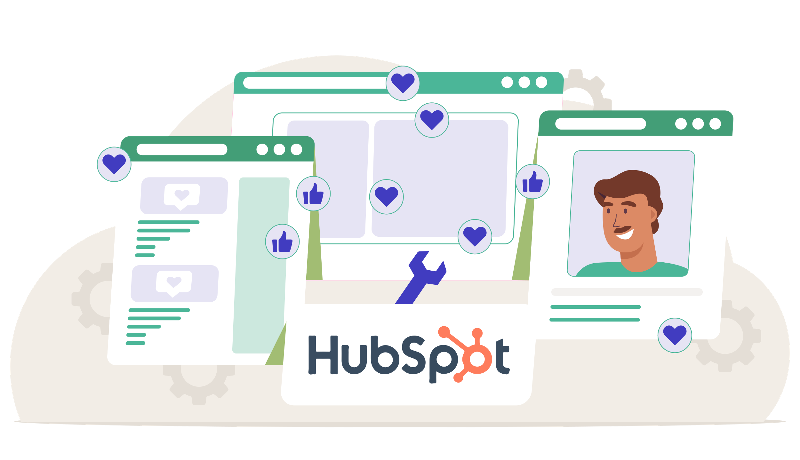Discover how HubSpot Marketing Hub can revolutionize social media marketing. Automate multi-channel postings and leverage AI to maximize engagement.
Facebook Hacks Every Startup Should Know
Facebook hacks are more important than ever for startups trying to build an audience. Facebook's algorithm changes have made organic reach challenging.
However, it's still possible to attract followers with a focused approach. Explore this Facebook beginner's guide to help attract more social media followers.
Grow your connections with these hacks:
1) Connect with people who think the way you think.
Send a messenger request along with a friend request. Or message them before sending the friend request. Another alternative is to comment on something they've posted below and ask if you can connect via messenger. This provides context, makes the interaction more human, and increases the likelihood of your friend or contact request being accepted: the first step to building a crucial relationship.
2) Offer assistance to those you connect with.
Ask if there's some way you might be able to help them. If you have ideas you think might be beneficial, ask if they'd like to hear them before putting them out there. You need to start a conversation before offering solutions.
3) Be Kind.
This might seem basic, but if you're consistently courteous and generous, those you're attempting to reach are more likely to respond in kind.
4) Have a purpose behind what you post.
Here are some ideas:
-
Lead generation.
-
Driving qualified traffic to your website.
-
Building trust and reputation in your target audience.
-
Community engagement.
-
Further building reputation and trust by posting relevant and helpful information.
-
Build your brand awareness.
5) Research and be strategic to get priority on Facebook's news feed:
We've done some of the leg work for you. Keep these tips in mind to get your posts seen on Facebook.
-
Post text with images and not just outbound links.
-
Post embedded videos, not just links to videos.
-
Share links to your content or site in the first comment rather than the post.
-
Share internal links to your group page, business page, or content in your group's articles section.
6) Engage in Facebook groups.
Like, share, and comment on other people's content within your group and in other relevant groups. This spreads your name and shows people you're willing to share the love. It also keeps you recent and relevant to this expanded audience.
7) Post during high-traffic days and times of day as indicated by Insights.
8) Boost your posts for likes to help build your Facebook community.
You can view who liked your post and invite them to like your startup's Facebook page. You can also message them individually and build relationships.
Best practices for the company page
9) Be engaging.
How do you do that?
-
Post in a way that catches people's attention and moves them to take action.
-
Post questions, fill in the blanks, or photos that ask questions.
10) Leverage Facebook ads
Why? Because:
-
They are a vital part of Facebook and should be part of your marketing strategy, even if people like to complain about them.
-
It's tough to grow a targeted and active page without spending some money on ads to help find qualified potential customers.
11) Have a posting strategy
Every page is different and has a different message and goal. You need to determine what kind of identity and tone you'd like your page to have and what content will get the best reaction from potential customers and fans.
12) Be human on your page
Nobody likes feeling like they're interacting with a robot.
-
Talk about current issues in the first person.
-
Refer to people you're interacting with in comments and messages by name.
-
Be understanding, kind, and respectful.
13) Use hashtags intelligently
Like them or not, hashtags are effective when used correctly. A couple of no-nos:
-
Don't use them in every post.
-
Don't hijack a common hashtag to try and show up in results.
-
Don't tag meaningless words.
-
Don't stuff your post; one or two are adequate.
14) Monitor page insights
Facebook Insights and analytics are part of determining the performance of your marketing efforts, and recent improvements make it easier to figure out what the numbers and graphs mean.
15) Post photos
Everyone likes a well-placed image:
-
Images catch the audience's attention and are easy to consume.
-
Photos need to be an integral part of your posting strategy.
-
Photos have the lowest reach, but the engagement rate is higher than other post types.
16) Run contests
Everyone likes winning:
-
Contests are often very successful when launching a marketing campaign.
-
People like to win stuff.
-
Use a validated third-party app to conduct a contest on Facebook.
17) Upload a great profile picture
Put your best foot forward with a solid, relevant image.
-
This is the first thing fans and other users see in the news feed when communicating with them.
-
This is the most critical image you have on Facebook.
-
It should be your logo.
18) Leverage your cover photo
The size of the cover photo alone makes it stand out.
-
This is your prospective customer's first impression of you.
-
Be sure the image speaks to your brand but doesn't overdo it.
-
Don't use too much text, and avoid using low-quality images.
19) Complete the "About" section
As a consumer, there's nothing worse than clicking on an "About" section to learn more about a company, only to come up empty. Conversely, it's also a missed opportunity for any company that doesn't take the time to fill this section of its Facebook profile.
- List your website's URL as the first item in your About section.
- Put in something about your brand that conveys what you do, and if you have a brand motto, use it.
20) Have fun
Seriously, be light-hearted and have fun. Don't always be serious when in business mode.
-
Your fans will remember that your page made them laugh more than anything you could say about your latest gadget or product.
Tips for expanding your reach
21) Make sure your Name, Address, and Phone number are correct on your page.
22) Research and employ long tail keywords across the social media board
(in posts, in your "About" section, in descriptions, etc.).
-
If you're not fluent in SEO speak, these are longer, more specific terms people might use to find information.
-
It matters in social media since you want to be found by as many customers as possible, so you need your page to be as relevant as possible to exactly what they're looking for.
-
Focus on what your target customers search for and the words they use, then model your page and content afterward.
23) Put keywords in strategic places.
The most relevant areas for search are your page name, the About section, and your posts.
24) Be sure you link to your Facebook page from any of your other channels.
The more links that point back to your Facebook page, the higher it will rank for a search. So link to your Facebook page from your website, Twitter account, and in your bio.
25) Use reviews.
Reviews should be a priority. They aren't super hard to get, and they go a long way in building trust in your brand.
-
Reviews boost credibility, trust, and sales, increasing your page's chances of appearing in search results on Facebook (and Google).
-
Studies show a majority of consumers will give a local business a review if you ask them.
26) Use original images in your cover photo.
27) Use images in every post.
28) Get free publicity by telling your audience to add tags to your live event photos.
You Might Also Like This Post:
29) Publish more videos since Facebook's algorithm prioritizes videos over other content.
30) Get your post timing right.
Yes, the time of the day you're posting content matters. So does the day of the week.
-
Check your page Insights to see what days/times are best for your company.
-
Use that data to study different types of posts and how/when they're most frequently interacted with.
31) Get your frequency right.
Post too much, and your engagement will drop. Post too little, and you will stop showing up on people's feeds.
-
A best practice is no more than three posts a day.
-
Run your test and study your Insights data to find out what's the magic number for your company.
-
Page engagement is your top priority, so adjust frequency accordingly.
-
Once you've got your frequency and timing adjusted, be consistent.
32) Promote your page.
Quality content and paying to promote your content must work together on Facebook. Often, paid ads or promotions attract customers, and your good content keeps them around. There's a promote button next to your page options.
33) Promote engaging content.
The organic reach of your Facebook posts increases the more your audience interacts with them. Engagement is critical. As more and more people like and comment on your posts, Facebook gives you an organic boost so more people see your stuff.
34) Retarget your website visitors.
Install Facebook pixel on your website, and you can show relevant ads to anyone who has visited automatically, regardless of whether or not they gave you their email address.
35) Make use of custom audiences.
This feature lets you use the information you already have for your customers; it's like retargeting but consists of people who've shown interest or are already customers.
36) Use lookalike audiences.
Facebook allows you to create an audience that shares interests or backgrounds with your current custom audience.
37) Provide value.
In conclusion, your Facebook page is not a platform for you to sell your products. Your Facebook page is a community. It's a place to build trust and loyalty. It shines a direct spotlight on your company and your brand.
So, as we mentioned, there's a definite place for promoting content in the world of Facebook. Still, there's also a substantive need to focus on solving your audience's problems and giving them what they want rather than always focusing on making a profit. Follow the 80/20 rule: 80% of your content should solve problems and provide information, while 20% is for promoting your widget.
Facebook is a place to make your company useful, memorable, relatable, and valuable to your following. Put your best foot forward by showing your personality and helping customers where they need it, and you'll be well on your way to mastering marketing on Facebook.
Looking for more help to market your startup? Get in touch with us!
This content is also available in:
- German: Facebook-Hacks, die jedes Startup kennen sollte
- Spanish: Los trucos de Facebook que toda startup debe conocer
- French: Hacks Facebook que toute startup devrait connaître
- Italian: Gli hack di Facebook che ogni startup dovrebbe conoscere
- Romanian: Hack-uri Facebook pe care orice start-up ar trebui să le cunoască
- Chinese: 每家初创企业都应了解的 Facebook 黑客










Leave a Comment